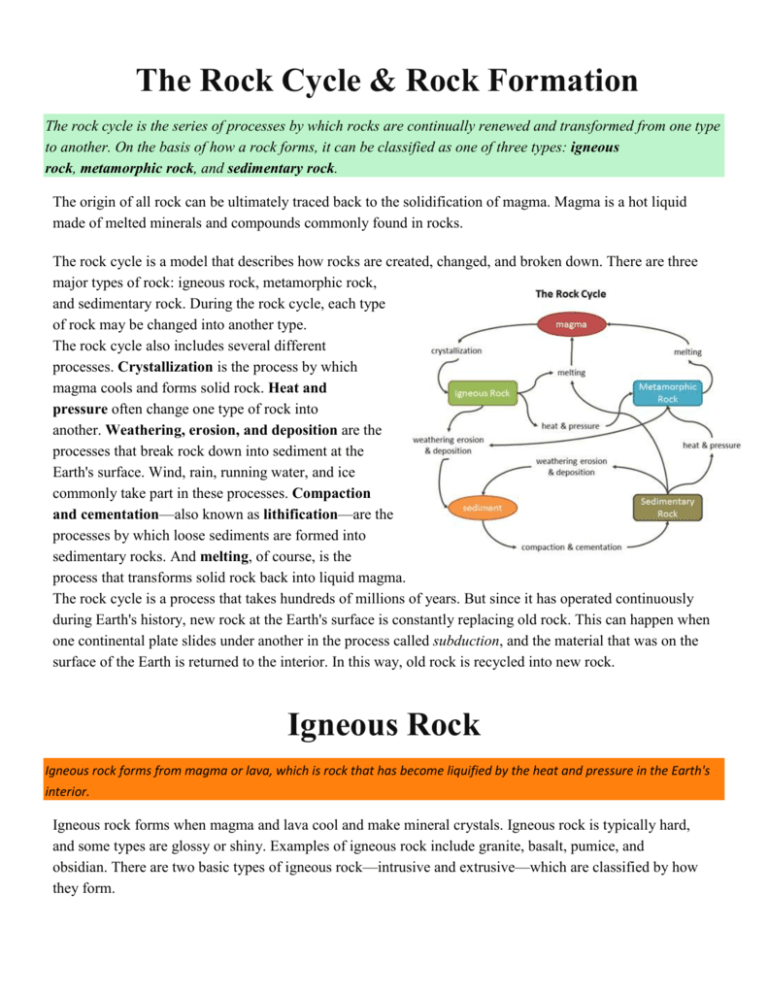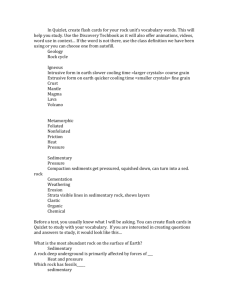Rock Cycle & Rock Formation: Igneous, Sedimentary, Metamorphic
advertisement

The Rock Cycle & Rock Formation The rock cycle is the series of processes by which rocks are continually renewed and transformed from one type to another. On the basis of how a rock forms, it can be classified as one of three types: igneous rock, metamorphic rock, and sedimentary rock. The origin of all rock can be ultimately traced back to the solidification of magma. Magma is a hot liquid made of melted minerals and compounds commonly found in rocks. The rock cycle is a model that describes how rocks are created, changed, and broken down. There are three major types of rock: igneous rock, metamorphic rock, and sedimentary rock. During the rock cycle, each type of rock may be changed into another type. The rock cycle also includes several different processes. Crystallization is the process by which magma cools and forms solid rock. Heat and pressure often change one type of rock into another. Weathering, erosion, and deposition are the processes that break rock down into sediment at the Earth's surface. Wind, rain, running water, and ice commonly take part in these processes. Compaction and cementation—also known as lithification—are the processes by which loose sediments are formed into sedimentary rocks. And melting, of course, is the process that transforms solid rock back into liquid magma. The rock cycle is a process that takes hundreds of millions of years. But since it has operated continuously during Earth's history, new rock at the Earth's surface is constantly replacing old rock. This can happen when one continental plate slides under another in the process called subduction, and the material that was on the surface of the Earth is returned to the interior. In this way, old rock is recycled into new rock. Igneous Rock Igneous rock forms from magma or lava, which is rock that has become liquified by the heat and pressure in the Earth's interior. Igneous rock forms when magma and lava cool and make mineral crystals. Igneous rock is typically hard, and some types are glossy or shiny. Examples of igneous rock include granite, basalt, pumice, and obsidian. There are two basic types of igneous rock—intrusive and extrusive—which are classified by how they form. Intrusive Igneous Rock Intrusive igneous rock forms underground, within the Earth's crust or mantle, where magma cools slowly. Because it cools slowly, intrusive igneous rock typically has large mineral crystals. Granite is a common type of intrusive igneous rock. The relatively large mineral crystals are easy to see with the naked eye. Extrusive Igneous Rock Extrusive igneous rock forms above ground, as lava and other materials that erupt from volcanoes cool quickly. Because they cool quickly, extrusive igneous rocks have small mineral crystals. Basalt is a common type of extrusive igneous rock. Individual mineral crystals in basalt are small and difficult to see. This image shows fresh basalt as it forms from cooling lava. Obsidian is another type of extrusive igneous rock. Because it forms from rapidly cooling rock, the crystals in it are so small that the surface of obsidian glossy. Obsidian is sometimes called volcanic glass because it is smooth and shiny with a glass-like texture. Pumice is yet another kind of rock formed from hardened lava. It has a different texture from either obsidian or solid basalt. Because small bubbles of gas were trapped within the lava as it cooled, pumice contains large quantities of holes.These cause pumice to have a rough, sandpaper-like texture and to have a density that is lower than most other types of rock. This piece of pumice has holes where gas bubbles were trapped while the lava cooled. is Sedimentary Rock Sedimentary rock forms when rock fragments and mineral grains become compacted and cemented together. Sedimentary rock may contain fossils and be striped or layered in appearance. Formation of Sedimentary Rock Most sedimentary rocks form from deposition, compaction, and cementation of sediment. Sediment is made up of small rock and mineral particles. These particles are weathered from larger rocks by agents such as wind and water. These weathered particles are then eroded, or transported to a new location, where they are deposited. Sediment may also contain plant and animal matter. As more sediment is deposited, it stacks up in layers. Eventually, the upper layers put pressure on the lower layers. This causes sediments to pack closer together in a process called compaction. Through the process of cementation, minerals from groundwater form between sediment grains, connecting the grains together to form rock. Other types of sedimentary rock, called evaporites, such as rock salt, form when minerals are left behind by evaporating water. Rock salt, also known as halite, is an example of an evaporite. Sedimentary Rock Characteristics Sedimentary rocks often occur in distinct layers and sometimes contain fossils. Sedimentary rocks that are well-cemented hold together well, while poorly cemented rocks tend to crumble more easily. Sandstone Coal Sedimentary rocks commonly form in layers. These rock layers in the Grand Canyon represent a variety of sedimentary rock types, including sandstone, siltstone, shale, limestone, and dolomite. Dolomite Siltstone Examples of Sedimentary Rock Some common sedimentary rock types include sandstone, siltstone, coal and shale. Sedimentary rocks that form mainly from chemical processes include limestone and dolomite. Limestone Shale Metamorphic Rock Metamorphic rocks are formed when pre-existing rocks are exposed to intense heat and pressure. Metamorphic Rock Formation Tectonic forces can push all types of rocks deeper into the Earth. These rocks are then subjected to extreme heat and pressure. If the rocks do not become hot enough to melt, these conditions can cause the crystal structure and texture of the rocks to change, forming a new kind of rock. Metamorphic rocks are rocks that form from sedimentary, igneous, or old metamorphic rocks that are subjected to extreme heat and pressure. Metamorphic rocks are so named because the termmetamorphosis means "transformation" or "change." Characteristics of Metamorphic Rock Some rocks have certain mineral grains that become flattened and line up in parallel planes or that separate into light and dark compositional bands when exposed to heat and pressure. These scenarios result in foliated metamorphic rocks, such as phyllite and schist. Metamorphic rocks without these planes or bands are nonfoliated. Phyllite is an example of a foliated metamorphic rock. Phyllite forms under moderate temperature and pressure conditions relative to other types of metamorphic rocks. Slate Marble Examples of Metamorphic Rock Slate and gneiss are foliated rocks. Slate forms from shale, and gneiss forms from granite. Marble is a nonfoliated metamorphic rock that forms from the sedimentary rock limestone. Quartzite is a metamorphic rock that forms from quartz sandstone. Phyllite Schist Gneiss Quartzite Uses of Rock Rocks and minerals are earth materials. They have many uses, including construction, energy production, and decoration. A rock's properties determine what uses it might have. There are many different kinds of rocks on Earth. The different kinds of rock have different physical properties. These properties, such as strength and beauty, determine where and how a rock can used. Rocks Can be used for Building Rocks that are not harmed very much by the weather can be used for building things. These rocks can be pretty, but they do not have to be. They are used because they are strong. Granite Rocks that are very hard and also beautiful to look at are useful for making parts of buildings that get used and seen by people all the time and are exposed to the weather.Granite is a very pretty, hard kind of rock that is used to make counters, stairs, and floors. These stairs are made of granite. Granite is beautiful to look at, but also very strong. Limestone Rocks that are easy to get, easy to cut or carve, and stand up well to the weather can be used for building. Many structures left by ancient humans are made of limestone. In some places, entire cities are made of this kind of rock. Limestone can be used to make building materials and statues, such as these. Sandstone Sandstone is another kind of stone that is easy to cut into large blocks and small bricks with straight edges. For this reason, sandstone has been used for thousands of years to build large structures. Large sandstone blocks from ancient buildings remain today, even though the buildings are no longer standing. Gravel Some rocks are crushed into small pieces and used in construction of roads, railways, and buildings. The name of this crushed rock is gravel. The rock pieces that make up gravel are usually 2.5 inches or smaller. Gravel is an ingredient in concrete. Gravel is used alone on some roads, but on others, it is used underneath layers of other materials, such as asphalt. Sand Sand is made up of tiny pieces of rock. It can be found in a variety of locations, such as beaches, deserts, and the bottoms of rivers and oceans. Sand can be used for building. It is an ingredient in bricks, mortar (the material that holds bricks together), and concrete. This concrete sidewalk contains sand. Rocks Can be used to Produce Energy Coal One of the most important rocks to humans is coal. When burned in power plants, this sedimentary rock produces energy that is converted to electricity. Coal is burned to produce electrical energy in power plants like these. Rocks Can be Melted to Produce Metals Iron Ore Some types of rock contain minerals that can be purified to make metal. These kinds of rock are called ores. For example, iron ore is a rock-like substance that contains compounds made up partly of iron. The ore is melted, and the iron metal is purified. Then, the iron can be mixed with other metals to make steel. Steel is useful for constructing bridges, buildings, boats, cars, and many other things.







